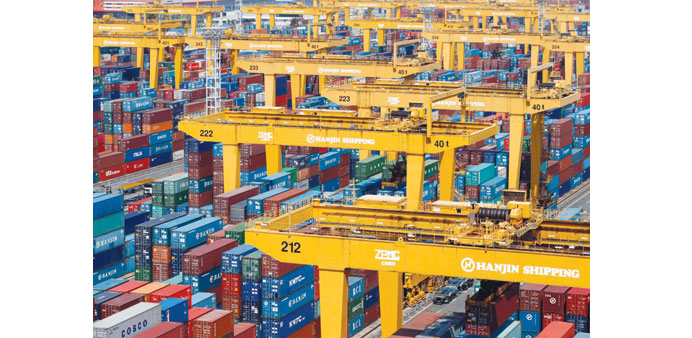Reuters
South Korea’s industrial output grew for a second month in July, adding to signs of improving domestic consumption, but some analysts are wagering on another interest rate cut as stubbornly weak global demand drags on the export-reliant economy.
The industrial output index rose by a seasonally adjusted 1.1% in July from June, the Statistics Korea data showed yesterday, which far outstripped market’s consensus view and followed a revised 2.6% jump in June.
The better result adds to recent signs that domestic demand in Asia’s fourth-largest economy may be picking up after slowing in the second quarter, but other data released yesterday and due out on Monday suggest that it’s too early to confirm a firm rebound.
Reflecting the fragility of the economic recovery, a central bank survey released earlier yesterday showed a sharp drop in business sentiment, while analysts surveyed by Reuters expect August exports growth and inflation to be tame.
Investment banks Nomura and ING made opposing assessments of the South Korean economy’s prospects, with Nomura suggesting more chances for an additional interest rate cut soon on top of this month’s reduction against ING’s view that a further easing is unlikely. “Overall, we see downside risks to our Q3 GDP growth forecast (1.2% quarter-on-quarter, 3.7% year-on-year) and therefore see the risk of another 25 bp rate cut to 2% in Q4 2014,” Young Sun Kwon, an economist at Nomura in Hong Kong, said in a research note.
The Bank of Korea, the country’s central bank, cut the policy interest rate early this month for the first time in 15 months by 25 basis points to 2.25% to join the government’s drive to stimulate domestic demand.
The rate cut was widely seen to have been made under government pressure, and a Reuters poll on the same day showed that 7 analysts expected the next move to be a rate cut while 11 tipped a hike. Earlier polls had shown most had expected the next move to be an increase.
Authorities led by Finance Minister Choi Kyung-hwan, who took office last month, have been pushing hard to stimulate demand, including an $11bn spending package, an easing of mortgage curbs and a proposal to prod big companies to invest more and pay more dividends.
The central bank did not give a clear guide on the future policy direction but analysts and bond investors were almost equally divided on the next rate move, highlighting the uncertainty about the outlook after the economy slowed to its weakest pace in over a year in the second quarter.
ING was bullish, underscoring the division in the markets on future rates policy: “The economy’s strong third quarter start leads us to review our 3Q GDP growth forecast. The data undermine the case for more BoK accommodation.”
Still, exports have underperformed in recent months, putting the brakes on the economy just as a ferry disaster in April darkened the public’s mood and took a toll on consumption. Indeed, South Korean exports are seen growing just 0.2% in August from a year earlier and inflation holding steady in August at a low level of 1.6%, according to median forecasts from the Reuters survey.
South Korea’s finance ministry also discounted the strong July industrial output data, warning in a statement that the output in August could suffer a setback due to partial strikes by unionised automobile workers and bad weather conditions.
The July output growth of 1.1% beat a median 0.3% gain tipped in a Reuters survey but followed a downward revision of the June reading to a 2.6% gain from a provisional 2.9% rise. The central bank said early yesterday that the business outlook index compiled from its survey of manufacturing firms fell to a seasonally adjusted 75 for September, the lowest since May last year, from 80 for August.
Markets showed a muted reaction to the mixed set of data, with the front-month futures on three-year treasury bonds gaining 0.06 point to 107.03 by 0245 GMT, while the won trading nearly flat at 1,015.0 per dollar.



